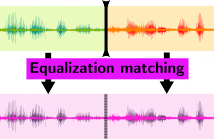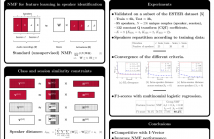- Transducers
- Spatial and Multichannel Audio
- Source Separation and Signal Enhancement
- Room Acoustics and Acoustic System Modeling
- Network Audio
- Audio for Multimedia
- Audio Processing Systems
- Audio Coding
- Audio Analysis and Synthesis
- Active Noise Control
- Auditory Modeling and Hearing Aids
- Bioacoustics and Medical Acoustics
- Music Signal Processing
- Loudspeaker and Microphone Array Signal Processing
- Echo Cancellation
- Content-Based Audio Processing
- Read more about STRUCTURALLY-CONSTRAINED GRADIENT DESCENT FOR MATRIX FACTORIZATION IN HAPLOTYPE ASSEMBLY PROBLEMS
- Log in to post comments
poster.pdf
- Categories:
 10 Views
10 Views- Read more about Audio Word Similarity for Clustering with Zero Resources based on iterative HMM Classification
- Log in to post comments
Recent work on zero resource word discovery makes intensive use of audio fragment clustering to find repeating speech patterns. In the absence of acoustic models, the clustering step traditionally relies on dynamic time warping (DTW) to compare two samples and thus suffers from the known limitations of this technique. We propose a new sample comparison method, called 'similarity by terative classification', that exploits the modeling capacities of hidden Markov models (HMM) with no supervision.
- Categories:
 8 Views
8 Views
- Read more about EQUALIZATION MATCHING OF SPEECH RECORDINGS IN REAL-WORLD ENVIRONMENTS
- Log in to post comments
When different parts of speech content such as voice-overs and narration are recorded in real-world environments with different acoustic properties and background noise, the difference in sound quality between the recordings is typically quite audible and therefore undesirable. We propose an algorithm to equalize multiple such speech recordings so that they sound like they were recorded in the same environment. As the timbral content of the speech and background noise typically differ considerably, a simple equalization matching results in a noticeable mismatch in the output signals.
- Categories:
 11 Views
11 Views- Read more about Optimal Transport between Copulas for Clustering Time Series
- Log in to post comments
- Categories:
 11 Views
11 Views- Read more about Pilot Aided Direction of Arrival Estimation for mmWave Cellular Systems
- Log in to post comments
Direction of arrival (DoA) estimation of high-resolution beams is critical for cell search and maintaining communication in millimeter wave (mmWave) cellular systems. All-digital solutions for DoA estimation, however desirable for their flexibility and performance, are impractical because of their use of high-speed, power hungry Analog-Digital Converters (ADCs) at each antenna element. In this paper we take a novel approach to formulate a fully digital DoA estimation solution.
- Categories:
 34 Views
34 Views- Read more about TIME DOMAIN ACOUSTIC CONTRAST CONTROL IMPLEMENTATION OF SOUND ZONES FOR LOW-FREQUENCY INPUT SIGNALS
- Log in to post comments
Sound zones are two or more regions within a listening space where listeners are provided with personal audio. Acoustic contrast control (ACC) is a sound zoning method that maximizes the average squared sound pressure in one zone constrained to constant pressure in other zones. State-of-the-art time domain broadband acoustic contrast control (BACC) methods are designed for anechoic environments. These methods are not able to realize a flat frequency response in a limited frequency range within a reverberant environment.
- Categories:
 24 Views
24 Views- Read more about A MAXIMUM LIKELIHOOD-BASED UNSCENTED KALMAN FILTER FOR MULTIPATH MITIGATION IN A MULTI-CORRELATOR BASED GNSS RECEIVER
- Log in to post comments
In complex environments, the presence or absence of multipath signals not only depends on the relative motion between the GNSS receiver and navigation satellites, but also on the environment where the receiver is located. Thus it is difficult to use a specific propagation model to accurately capture the dynamics of multipath signal parameters when the GNSS receiver is moving in urban canyons or other severe obstructions. This paper introduces a statistical model for the line-of-sight and multipath signals received by a GNSS receiver.
- Categories:
 12 Views
12 Views
Automated objective methods of audio evaluation are fast, cheap, and require little effort by the investigator. However, objective evaluation methods do not exist for the output of all audio processing algorithms, often have output that correlates poorly with human quality assessments, and require ground truth data in their calculation. Subjective human ratings of audio quality are the gold standard for many tasks, but are expensive, slow, and require a great deal of effort to recruit subjects and run listening tests.
- Categories:
 20 Views
20 Views
- Read more about Group nonnegative matrix factorisation with speaker and session variability compensation for speaker identification
- Log in to post comments
This paper presents a feature learning approach for speaker identification that is based on nonnegative matrix factorisation. Recent studies have shown that with such models, the dictionary atoms can represent well the speaker identity. The approaches proposed so far focused only on speaker variability and not on session variability. However, this later point is a crucial aspect in the success of the I-vector approach that is now the state-of-the-art in speaker identification.
- Categories:
 7 Views
7 Views